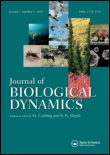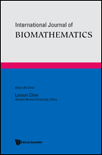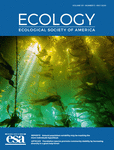
Journal of Biological Dynamics
Scope & Guideline
Pioneering open access to the latest in ecological research.
Introduction
Aims and Scopes
- Mathematical Modeling of Biological Systems:
The journal primarily publishes research that employs mathematical models to explore various biological phenomena, such as population dynamics, disease spread, and ecological interactions. - Epidemiological Dynamics:
A significant focus is on the modeling of infectious diseases, including the dynamics of transmission, vaccination strategies, and control measures. This area encompasses models for diseases like COVID-19, HIV/AIDS, and tuberculosis. - Ecological Interactions and Population Dynamics:
Research often investigates predator-prey relationships, competitive interactions, and the impact of environmental factors on species dynamics, utilizing both deterministic and stochastic modeling approaches. - Optimal Control Strategies:
The journal frequently features studies that develop optimal control strategies for managing biological systems, particularly in the context of infectious diseases and ecological management. - Stochastic Modeling:
There is a consistent emphasis on stochastic modeling techniques to address uncertainties in biological systems, allowing for a more realistic representation of dynamic processes.
Trending and Emerging
- COVID-19 and Infectious Disease Modeling:
There has been a significant increase in the publication of models addressing COVID-19 dynamics, including transmission, control strategies, and the impact of vaccination, demonstrating the journal's relevance in the context of global health crises. - Multiscale and Complex Systems Modeling:
Emerging research focuses on multiscale models that integrate various biological processes, such as interactions across different levels of biological organization (e.g., cellular, individual, population), reflecting a trend towards complexity in biological modeling. - Interdisciplinary Approaches and Behavioral Dynamics:
An increasing number of studies are incorporating behavioral dynamics into models, exploring how behavior influences disease spread and ecological interactions, highlighting the integration of social sciences into biological modeling. - Adaptive and Stochastic Strategies:
Research is increasingly focusing on adaptive strategies in biological systems, including responses to environmental changes and stochastic events, indicating a shift towards understanding the resilience and adaptability of populations. - Optimal Control and Economic Analysis:
There is a growing interest in the development of optimal control strategies that also consider economic implications, particularly in the context of public health interventions and resource allocation.
Declining or Waning
- Classical Population Models:
Traditional population models, such as simple Lotka-Volterra systems, seem to be less frequently featured in recent publications, possibly due to the shift towards more complex and realistic modeling approaches that account for multiple species and environmental factors. - Single-Species Dynamics:
There is a noticeable decrease in studies focusing exclusively on single-species dynamics without the consideration of interactions with other species or environmental influences, as researchers increasingly prioritize multi-species and ecosystem-based approaches. - Static Models with Limited Application:
Models that do not incorporate dynamic elements or fail to address real-world applications appear to be less favored in recent issues, indicating a trend towards more practical and applicable research.
Similar Journals

AMERICAN NATURALIST
Connecting Scholars through Natural InsightsAMERICAN NATURALIST, published by University of Chicago Press, stands as a premier outlet for scholarly research in the fields of ecology, evolution, behavior, and systematics. With an impact factor that reflects its high citation rate, the journal has garnered a reputation within the academic community, evidenced by its placement in the Q1 category of its discipline in 2023 and an impressive Scopus rank of #135 out of 721 journals, positioning it in the 81st percentile for Agricultural and Biological Sciences. The journal, established in 1946, continues to uphold its commitment to advancing scientific knowledge through rigorous peer-reviewed articles. Researchers and professionals will find AMERICAN NATURALIST an essential resource, providing insights and discussions that illuminate complex biological phenomena, while fostering a deeper understanding of the natural world. As an essential reading for students and seasoned experts alike, its curated body of work encourages innovative thinking and exploration across an array of ecological and evolutionary topics.

ARDEA
Elevating the study of birds with impactful insights.ARDEA, published by the Nederlandse Ornithologische Unie, is a prominent journal in the fields of Animal Science, Zoology, and Ecology. With its rich history spanning from 1981 to the present, ARDEA serves as a vital platform for researchers and professionals dedicated to avian studies and the ecological sciences. This quarterly journal is recognized in the Q3 category for both Animal Science and Ecology, as per the latest rankings, and maintains an impressive global standing within its subject areas. Although it operates without an open access model, the journal provides significant insights and contributions to the understanding of bird biology, conservation, and evolution. Researchers and students seeking to advance their knowledge in ornithology and related fields will find ARDEA to be an indispensable resource, promoting high-quality research and fostering academic collaboration.

PARASITOLOGY
Empowering researchers with critical knowledge in parasitology.PARASITOLOGY, published by Cambridge University Press, is a prestigious journal that has been at the forefront of research in the field of parasitology since its inception in 1908. This esteemed publication carries the ISSN 0031-1820 and E-ISSN 1469-8161, and its rigorous peer-reviewed articles provide insights into both fundamental and applied aspects of parasitic biology, infectious diseases, and host-parasite interactions. With a commendable impact factor, PARASITOLOGY ranks in the top quartile (Q1) for Animal Science and Zoology and holds Q2 rankings in both Infectious Diseases and Parasitology categories, indicating its significant influence and contribution to these disciplines. The journal's diverse scope allows for a broad range of research articles, reviews, and case studies, making it an essential resource for researchers, professionals, and students seeking to stay updated on the latest developments in the field. Based in the United Kingdom, PARASITOLOGY offers valuable access to critical research in an era where understanding parasitic diseases is more vital than ever, and continues to shape the future of this important scientific field.

POPULATION ECOLOGY
Unraveling the complexities of biodiversity and conservation.Population Ecology is a leading journal dedicated to the advancement of research in the field of ecology, evolution, and behavior, published by the esteemed Wiley in Japan. With an impact factor indicative of its academic significance and ranked Q2 in the 2023 Ecology category, this journal serves as a pivotal resource for researchers, professionals, and students alike, facilitating the dissemination of high-quality research and innovative discussions. Covering diverse aspects of ecological dynamics, population processes, and their evolutionary implications, Population Ecology fosters a deeper understanding of species interactions and environmental factors shaping ecosystems. Available in both print and online formats (E-ISSN 1438-390X), the journal is committed to open access to enhance public engagement and accessibility to crucial scientific findings, ultimately contributing to informed decision-making regarding biodiversity and conservation efforts. With a robust ranking of #235 out of 721 in Agricultural and Biological Sciences, it is poised to remain at the forefront of ecological research through 2024 and beyond.

International Journal of Biomathematics
Exploring the Nexus of Mathematics and BiologyInternational Journal of Biomathematics is a premier scholarly publication dedicated to the intersection of mathematics and biological sciences. Published by World Scientific Publishing Co Pte Ltd in Singapore, this journal serves as a vital resource for researchers and practitioners seeking to explore the quantitative modeling of biological systems. Recognized for its significant contributions to Applied Mathematics and Modeling and Simulation, it achieved a commendable Q2 ranking in both categories in 2023, reflecting its impact within the academic community. The journal, with ISSN 1793-5245 and E-ISSN 1793-7159, promotes open access to facilitate the dissemination of knowledge and encourages submissions that advance the theoretical and practical applications of biomathematics. With a commitment to fostering interdisciplinary collaboration, the International Journal of Biomathematics plays an essential role in shaping the future of research in mathematical biology.

ECOLOGY
Advancing ecological understanding through rigorous research.ECOLOGY, published by Wiley, stands as a premier journal in the field of ecology, providing a vital platform for the dissemination of innovative research and insightful reviews that span various aspects of ecology, evolution, behavior, and systematics. With an impressive impact factor and ranked Q1 in the most recent category quartiles, the journal enjoys a distinguished reputation among scholars, featuring in the 92nd percentile for its subject area according to Scopus. The journal's rigorous peer-review process ensures that the published studies contribute significantly to understanding complex ecological dynamics and advancing the field's theoretical frameworks. Researchers, professionals, and students alike benefit from the rich archive that extends from 1973 to 2024, fostering interdisciplinary dialogue and collaboration. Though not an open-access journal, ECOLOGY remains committed to maintaining high standards of scholarly communication, making it an indispensable resource for anyone dedicated to the ecological sciences.

JOURNAL OF VECTOR ECOLOGY
Pioneering Insights in Ecology and EvolutionJOURNAL OF VECTOR ECOLOGY, published by SOC VECTOR ECOLOGY, serves as a pivotal platform for the dissemination of research in the interdisciplinary fields of ecology, evolution, behavior, and systematics. Established in 1996 and operating from the United States, this esteemed journal boasts an impressive Q2 ranking in Ecology as of 2023, showcasing its significant contribution to the scientific understanding of vector ecology and its implications on public health and environmental management. The journal is indexed in Scopus, ranking #341 out of 721 in Agricultural and Biological Sciences focusing on Ecology, Evolution, Behavior and Systematics and #222 out of 461 in Environmental Science, highlighting its relevance and impact within these domains. Although it does not currently offer open access options, the JOURNAL OF VECTOR ECOLOGY remains committed to advancing knowledge and fostering collaboration among researchers, professionals, and students dedicated to vector analysis and control strategies.

Izvestiya Instituta Matematiki i Informatiki-Udmurtskogo Gosudarstvennogo Universiteta
Illuminating the Path of Computational AdvancementsIzvestiya Instituta Matematiki i Informatiki-Udmurtskogo Gosudarstvennogo Universiteta is a distinguished academic journal published by Udmurt State University, located in the Russian Federation. Focusing on the fields of mathematics and computer science, particularly in Computational Theory and Mathematics, the journal is a vital platform for researchers and professionals to disseminate innovative findings and theoretical advancements. With an ISSN of 2226-3594 and an E-ISSN of 2410-1737, it holds a Q3 categorization in both Computational Theory and Mathematics and Mathematics (miscellaneous) for the year 2023, signifying its role in contributing to scholarly discourse. The journal has been operational since 2019, with a commitment to enhance understanding in its domain through the publication of original research articles, reviews, and technical notes. Although not currently open access, its content is crucial for those engaged in mathematical and computational sciences, providing insights that can impact both theoretical and practical applications. Researchers, professionals, and students alike will find valuable resources within its pages as they navigate the complexities of contemporary mathematical challenges and computational methodologies.

ENVIRONMENTAL BIOLOGY OF FISHES
Advancing knowledge in aquatic ecosystems.ENVIRONMENTAL BIOLOGY OF FISHES, published by SPRINGER, is a premier journal in the fields of Aquatic Science and Ecology, Evolution, Behavior and Systematics. With a rich history spanning from 1976 to 2024, this esteemed journal provides a platform for groundbreaking research that addresses critical issues such as fish ecology, species behavior, and environmental influences on aquatic life. Recognized for its significant contributions, it holds a Q2 ranking in both the Aquatic Science and Ecology categories, reflecting its influence and relevancy in the academic community. The journal's focus on innovative ecological studies makes it an essential resource for researchers, professionals, and students dedicated to advancing our understanding of fish biology and the broader ecological systems of which they are a part. Although not an open-access publication, the insights and findings presented in its articles are invaluable for those engaged in the preservation and sustainable management of aquatic environments.

Theoretical Ecology
Advancing ecological insights through rigorous modeling.Theoretical Ecology, published by SPRINGER HEIDELBERG, is a premier journal in the field of ecological modeling and theory, exemplifying the intersection of rigorous quantitative analysis and ecological understanding. With its ISSN 1874-1738 and E-ISSN 1874-1746, this journal has been a valuable resource for researchers since its inception in 2008, with a commitment to publish cutting-edge research until 2024. The journal's 2023 category quartiles demonstrate its impact, ranking Q3 in Ecological Modeling and Q2 in Ecology, reflecting its significance within the academic community. Furthermore, its Scopus rankings position it among the top tier of environmental science journals, ranking #181/461 in Ecology and #21/41 in Ecological Modeling. While the journal does not offer open access, it is an essential publication for those looking to deepen their understanding of theoretical frameworks that drive ecological research and practice. By providing a platform for innovative theories and models, Theoretical Ecology plays a crucial role in shaping future ecological studies and informing policy decisions in environmental management.